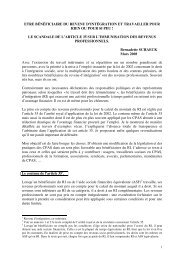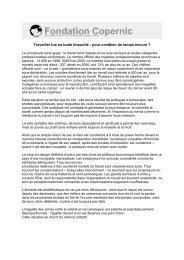Awra Amba RJ 300612 EN - Contacter un comité local d'Attac
Awra Amba RJ 300612 EN - Contacter un comité local d'Attac
Awra Amba RJ 300612 EN - Contacter un comité local d'Attac
You also want an ePaper? Increase the reach of your titles
YUMPU automatically turns print PDFs into web optimized ePapers that Google loves.
<strong>Awra</strong> <strong>Amba</strong>, a current experiment of utopian socialism<br />
by At05/70, only 4 or 5 men bury the deceased, while others work normally. There is therefore no<br />
important gathering of relatives, nor wailing, which are compared to salt on a wo<strong>un</strong>d (Yi07/63). The<br />
body is simply wrapped in a new shroud and then buried (At05/70). There is no f<strong>un</strong>eral ceremony,<br />
because "if we have something to tell to someone, it must be done in his lifetime", and everyone,<br />
including the close relatives of the deceased, go back to their daily routines (Yi07/51; Ya08/86;<br />
Jo10b/5). The mourning lasts at most <strong>un</strong>til the evening. People gather in the evening in the house of<br />
the deceased person to play, joke and discuss, while they are spinning cotton (At05/70).<br />
The refusal of any mourning rite with the relatives after the burial is very severely judged by the<br />
neighbours of <strong>Awra</strong> <strong>Amba</strong>, which judge that absolutely inhuman. So, a women living in the<br />
neighbouring village of Jib Gudguad says to Yi07/63: "To express our sympathy and so that our<br />
friend does not think about the dead person again and again, we have to be with him at least for some<br />
time or some days. This is a part of our culture that I am proud of. Contrary to what they think [in<br />
<strong>Awra</strong> <strong>Amba</strong>], we are not going here to get something to eat, nor to rest. They are really very weak in<br />
this regard."<br />
These burial rites correspond to the social and cultural system of <strong>Awra</strong> <strong>Amba</strong>, whose members do<br />
not believe to a life after death and privilege the life on Earth, for instance by taking great care to the<br />
sick and the elderly. The mourning of the deceased by its very close relatives is furthered according<br />
to <strong>Awra</strong> <strong>Amba</strong> members by the daily work, which starts again immediately after the death rather<br />
than – in the surro<strong>un</strong>ding comm<strong>un</strong>ities – by long f<strong>un</strong>erals, which show gradually to the close<br />
relatives that the deceased no longer belongs to the society (At05/71). If it is <strong>un</strong>derstandable the<br />
neighbours judge inhuman the behaviour of the inhabitants of <strong>Awra</strong> <strong>Amba</strong> – in relation with their<br />
own practices and beliefs, there is no firm evidence that the death of a close relative is felt more<br />
strongly in <strong>Awra</strong> <strong>Amba</strong> than elsewhere without proper investigation (Question 31 in Annex).<br />
For the death of someone they know in the surro<strong>un</strong>ding, the members of the <strong>Awra</strong> <strong>Amba</strong> comm<strong>un</strong>ity<br />
attend the f<strong>un</strong>erals because they believe it is a duty, but afterwards, they don't go the home of the<br />
family like other comm<strong>un</strong>ities (Yi07/51).<br />
In <strong>Awra</strong> <strong>Amba</strong>, all children inherit equally from their parents, and the comm<strong>un</strong>ity inherits in the<br />
absence of close family (At05/40).<br />
4.7. Management of conflicts internal to the comm<strong>un</strong>ity<br />
<strong>Awra</strong> <strong>Amba</strong> is first a large family whose members are very close each other. For instance, Atnafu<br />
(2005/39-40) states families build their houses side by side, come and go, work together; the 96<br />
households of the village at this time share four wooden mortars and five grinding stones. The adults<br />
care for and nurse each other's children. All avoid disturbing their neighbours by self-control and<br />
silence.<br />
The inherent dignity and well-being of every person, the equality between men and women, the due<br />
protection of and respect for children, the care for the elderly and the disabled people, the elimination<br />
of socio-economic, cultural and religious barriers, which create an artificial division between<br />
humans, are thought to constitute the real fo<strong>un</strong>dations of peace, justice and social harmony within the<br />
comm<strong>un</strong>ity (Me09/78). The source of the conflicts is for <strong>Awra</strong> <strong>Amba</strong> the lack of consideration for<br />
others not to treat others as we wish to be treated (Me09/42).<br />
Moreover, in case of conflict, the <strong>Awra</strong> <strong>Amba</strong> comm<strong>un</strong>ity developed a set of rules and mechanisms,<br />
which are mechanisms of conflict resolution.<br />
Those who quarrel are firstly invited to resolve their dispute between themselves (Me09/44). Family<br />
and interpersonal conflicts are then managed internally by the comm<strong>un</strong>ity through a family<br />
conference, an inter-spousal advisory cell, and a complaint hearing committee, which is one of the<br />
committees of the cooperative (see section 4.1 page 41). They are very simple and flexible<br />
60 / 85

















